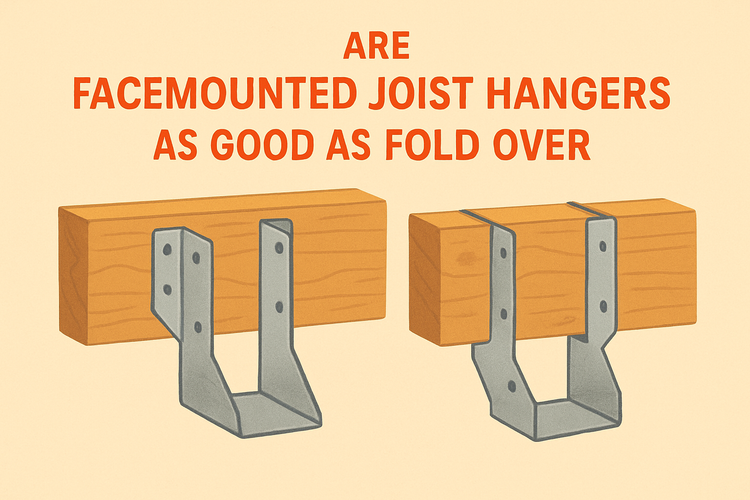Are Facemounted Joist Hangers As Good As Fold Over

Comparing Facemounted and Fold-Over Joist Hangers
Facemounted and fold-over joist hangers both offer reliable timber support, but they differ in design and application. Understanding these differences can help you determine the best choice for your project.
Facemounted joist hangers are fixed directly to a vertical surface, such as a ledger board or wall, providing strong support when there's no possibility to wrap over a joist. Fold-over joist hangers, on the other hand, are bent over the top of the joist, offering additional hold that can be essential for certain load-bearing applications. Your choice depends on the structural requirements and personal preference in ease of installation.
While facemounted hangers are easier to install in tight spaces, fold-over hangers may provide more lateral stability. Choosing between the two often comes down to evaluating the load direction, access, and the specific timber joint configuration. For a wider selection of suitable Joist Hangers, browse through our collection of engineered solutions.
Installation Strength and Stability
One of the primary factors in deciding between the two types is the structural integrity they offer. Facemounted hangers perform exceptionally well in vertical load scenarios.
Facemounted joist hangers are designed to transfer the vertical load directly into the supporting structure. When properly installed with approved Screws and Nails, they can offer excellent shear strength and hold weight as required by most residential or commercial load specs. They're optimal for decks, floors, and roofing systems where joists meet ledgers or beams.
Fold-over hangers wrap around the top of the joist, providing resistance not only to downward force but also to twisting and shifting. This makes them especially useful in zones subject to lateral stress or vibration. Builders favor fold-over designs in applications where heavy traffic or dynamic movement may be expected, including warehouse floors or raised outdoor platforms.
The key takeaway here is that while both types are structurally sound when installed correctly, your specific use case—such as joist height, environmental condition, and type of load—will determine which style performs better under the conditions.
Ease of Installation and Accessibility
Ease of installation varies significantly between facemounted and fold-over hangers. Accessibility to the joist plays a big role in your selection.
Facemounted hangers are often the go-to option when working with limited overhead or side clearance. Since they only require attachment to a supporting face, installers can fasten them directly to a wall or beam before dropping in the joist. This makes them popular in retrofit jobs or enclosed framing systems where top access is non-existent.
Fold-over hangers, however, require access to the top of the joist for wrapping around and securing. While this can be less convenient, it does provide additional grip and lateral stability once in place. They suit new construction better where full access is available before enclosing walls or ceilings. Fold-over variants also tend to involve more steps, increasing time spent on installation if working with many beams.
In terms of tools and equipment, both types are similar, requiring screws or nails for anchoring. For optimized performance, make sure to pair them with compatible metal fasteners. Incorrect fixings can compromise even the most well-installed connectors.
Cost Efficiency and Material Considerations
On a cost basis, differences between facemounted and fold-over versions aren't always substantial, but there are certainly considerations depending on project scale and installation complexity.
Facemounted hangers tend to be more straightforward to produce and install, making them slightly less expensive in many product lines. However, if additional bracing hardware is needed for lateral support, the overall cost may increase. They are a more economical option for straight vertical applications like residential floor framing or lightweight decking.
Fold-over hangers might have a higher unit cost and require more labor, but they can minimize the need for auxiliary bracing or reinforcement, potentially reducing material needs. In large scale or repetitive construction, this efficiency can help offset initial hardware costs.
Material choice is essential here. All hangers should be galvanized or coated as per environmental exposure. Coastal regions, for example, require corrosion-resistant products, which are available in both types. You can find toughened, coated versions of joist connection products in our Joist Hangers section, suitable for all weather applications.
When to Choose One Over the Other
Each type of hanger has its ideal application scenario, and knowing when to choose each can improve both performance and longevity of the timber structure.
If you’re working on a renovation or limited-access project, go for facemounted hangers. They’re easier to set up in confined areas and reduce complications when adding framing to existing construction. Additionally, they’re ideal when you’re working with engineered components like LVL or Glulam, which pair well with specific Connectors for Glulam Timber.
Use fold-over hangers when constructing new buildings or outdoor framing platforms where total joist access is available. Their full-wrap design offers superior twist resistance, making them suitable for seismic or windy zones. They work exceptionally well in systems where joist lift-out or movement poses a concern, particularly in suspended platforms or utility mezzanines.
Choosing the right option ultimately depends on your project layout, structural requirements, and environmental exposure zones. For best results, ensure compatibility with surrounding hardware like Joist Hangers and select fasteners that match load and treatment specifications.
